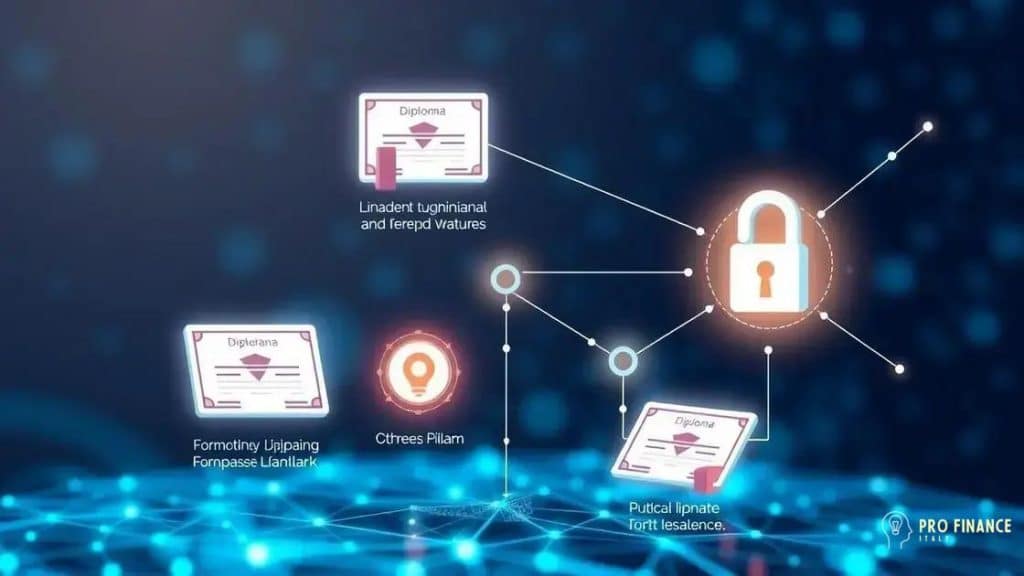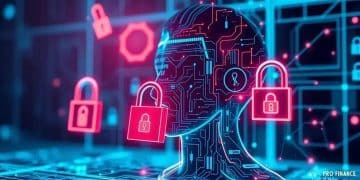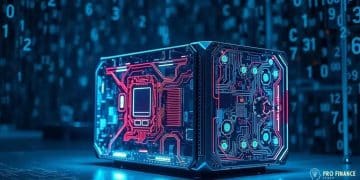The role of blockchain in enhancing academic credentials

The role of blockchain in enhancing academic credentials involves providing secure, easily verifiable digital records that ensure authenticity, streamline the verification process, and support the growing demand for personalized education paths.
The role of blockchain in enhancing academic credentials is becoming increasingly important. Have you ever wondered how this technology could ensure the authenticity of your diplomas? Let’s explore its potential!
Understanding blockchain technology
Understanding blockchain technology is essential to grasp how it can transform academic credentials. At its core, blockchain is a decentralized digital ledger that records transactions across many computers. This ensures that the recorded data cannot be altered retroactively without the alteration of all subsequent blocks. Imagine a secure, transparent system for verifying your educational achievements; that’s what blockchain offers.
How does it work?
The beauty of blockchain lies in its unique structure. Each block in the chain contains a number of transactions. When a new transaction occurs, it is added to a block. Once the block is filled, it is then chained to the previous block, creating a chronological order. This process makes it very difficult for any individual to manipulate the data. Each transaction is secure, time-stamped, and verified.
Key Features of Blockchain Technology
- Decentralization: No single entity has control over the entire blockchain.
- Immutability: Once information is added, it cannot be changed.
- Transparency: Users can verify transactions easily.
- Security: Uses cryptographic techniques to secure data.
These key features are what make blockchain attractive for educational institutions. By adopting this technology, schools and universities can issue digital diplomas that are nearly impossible to forge. This can help prevent diploma mills and ensure that only qualified individuals are recognized.
For students, having a blockchain-verified credential can greatly enhance their employability. Employers can trust that the degrees and certifications presented are legitimate. Moreover, this technology offers a way for individuals to control their credentials, sharing them with potential employers at their discretion.
As educational institutions explore the potential of blockchain, some are already implementing pilot programs to test its effectiveness. These experiments may soon pave the way for what could be a revolutionary change in how academic achievements are verified and shared.
Benefits of blockchain for academic credentials
The benefits of blockchain for academic credentials are transformative. This technology offers a new way to validate educational achievements, making them more secure and trustworthy. With blockchain, institutions can easily verify a student’s credentials without the need for an intermediary.
Enhanced Security
One of the main advantages is the enhanced security that blockchain provides. Since the data is stored across a network of computers, it is highly resistant to hacking and fraud. Institutions can issue digital diplomas that are virtually impossible to forge, protecting the integrity of academic records.
Streamlined Verification Process
Another benefit is the streamlined verification process. Employers and other institutions can verify credentials in real-time, saving time and reducing the hassle of traditional verification methods. This quick access to information can make a significant difference in hiring decisions.
- Faster verifications: Immediate access to records.
- Less paperwork: No need for physical documents.
- Increased trust: Employers can trust the legitimacy of credentials.
Blockchain also puts control back in the hands of students. With their credentials stored on the blockchain, individuals can share their academic records directly with employers, allowing for a more connected and transparent process. This also helps to build an accurate and comprehensive digital profile for job seekers.
Another crucial aspect is the potential for lifelong learning. As people engage in continuous education, blockchain can track all their certifications in one place. This gives employers a clearer picture of a candidate’s qualifications over time. Furthermore, institutions benefit from greater efficiency in credentialing, reducing administrative costs associated with record-keeping.
As educational systems evolve, the adoption of blockchain technology can lead to a more equitable and fair assessment of qualifications, leveling the playing field for all graduates. This innovative approach may also encourage more individuals to pursue advanced education, knowing the legitimacy of their achievements will always be preserved.
Real-world examples of blockchain in education
Real-world examples of blockchain in education highlight how this technology is being utilized to improve academic processes. Many institutions are already leveraging blockchain to enhance the transparency and security of educational credentials.
Example 1: MIT Digital Diplomas
One notable example is the Massachusetts Institute of Technology (MIT). They have issued blockchain-based diplomas. These diplomas provide a secure way for graduates to share their credentials with employers. Each diploma is linked to a blockchain entry, ensuring its authenticity. Employers can easily verify the information by accessing the blockchain.
Example 2: Stanford University
Stanford University is also exploring blockchain for educational records. They are testing a system that allows students to control their degrees and transcripts. This initiative aims to create a lifelong record of educational achievements. Students can share their records directly with potential employers.
Example 3: University of Nicosia
The University of Nicosia in Cyprus has been a pioneer in adopting blockchain technology in education. They offer a master’s program in digital currencies and provide blockchain-based certificates for their courses. This not only validates their programs but also teaches students about the potential of blockchain.
- Increased trust: With verified educational records, employers can trust the qualifications.
- Global reach: Blockchain allows credentials to be recognized worldwide.
- Empowered students: Learners have control over their data.
These examples illustrate the diverse applications of blockchain in the education sector. Institutions are not just adopting technology; they are also transforming how academic credentials are awarded and verified.
The ongoing exploration of blockchain in education demonstrates a commitment to innovation. As more schools adopt such systems, the landscape of educational credentials will continue to evolve, offering greater trust and efficiency.
Challenges in implementing blockchain in academia
Challenges in implementing blockchain in academia are significant and must be addressed for successful adoption. Although the potential benefits are clear, several hurdles must be overcome to integrate this technology effectively into educational systems.
Technical Barriers
One major challenge is the technical barrier associated with blockchain technology. Many educational institutions lack the necessary infrastructure and expertise to implement blockchain solutions. Training staff and updating systems can be costly and time-consuming.
Regulatory Issues
Regulatory concerns also pose a challenge. Different countries have varying laws regarding data privacy and security. Educational institutions need to ensure compliance with these regulations while adopting blockchain. This can complicate the integration process.
- Data privacy: Safeguarding student information is crucial.
- Interoperability: Systems must work together across different platforms.
- Legal uncertainties: Clarity on the legal status of blockchain records is needed.
Moreover, there is often resistance to change within academic institutions. Many educators and administrators may be unfamiliar with blockchain technology. This can lead to skepticism and reluctance to adopt new systems. Building trust and promoting understanding among stakeholders is vital.
Another significant challenge is the issue of cost. While blockchain can reduce administrative costs in the long run, the initial setup and implementation can be expensive. Institutions must assess their budget and resource allocation carefully.
These challenges highlight the complexity of integrating blockchain in education. However, with careful planning and collaboration among educational institutions, these obstacles can be addressed effectively. Overcoming these challenges will be essential for realizing the full potential of blockchain in enhancing academic credentials.
Future trends in blockchain and education
Future trends in blockchain and education are set to shape a new landscape for academic credentials. As technology continues to evolve, blockchain can bring more innovations, enhancing how education is delivered and how records are kept.
Increased Adoption of Micro-Credentials
One emerging trend is the rise of micro-credentials. These are short, focused courses that provide specific skills or knowledge. Blockchain can validate these credentials, making it easier for employers to verify skills and achievements. This allows for more personalized education paths which can cater to individual needs.
Integration with Other Technologies
Another trend is the integration of blockchain with other technologies, such as artificial intelligence and the Internet of Things (IoT). By combining these technologies, educational institutions can create smart learning environments. For instance, IoT devices can track student progress and achievements in real-time on a blockchain, providing a clear picture of a learner’s journey.
- Data-Driven Insights: Institutions can obtain insights from detailed records.
- Personalized Learning: Education can become more tailored to individual student needs.
- Enhanced Collaboration: Blockchain can facilitate collaboration between institutions.
Furthermore, the increasing demand for digital learning solutions is driving the use of blockchain. As online education continues to grow, securing digital credentials becomes essential. Blockchain provides a reliable method for ensuring that online degrees are legitimate and recognized worldwide.
Additionally, we may see a push towards global standards for educational credentials. Blockchain can enable the creation of a universal framework for verification, making it easier for students to transfer their qualifications across borders. This can enhance global mobility and create a more interconnected education system.
Ultimately, the future of blockchain in education looks promising. As institutions begin to understand and embrace its potential, we can expect exciting developments that will redefine how students achieve and prove their academic success.
FAQ – Frequently Asked Questions about Blockchain in Education
What is blockchain technology in education?
Blockchain technology in education is a decentralized digital ledger that securely records academic credentials and achievements, ensuring authenticity and transparency.
How can blockchain enhance the verification process for credentials?
Blockchain provides a fast and secure way for employers and institutions to verify academic records in real-time, reducing the need for manual verification.
What are micro-credentials, and why are they important?
Micro-credentials are short, focused educational certificates that validate specific skills. They are important because they allow for personalized learning paths and easy verification.
What challenges might institutions face when implementing blockchain?
Challenges include technical barriers, regulatory compliance issues, and resistance to change within educational organizations.





